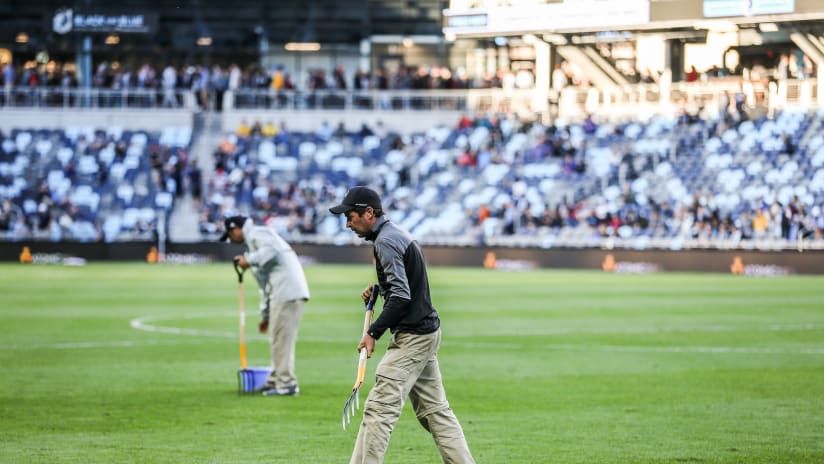The pitch at Allianz Field has been in the spotlight ever since the home opener, when grounds crews had to move eight inches of April snow off the still-adjusting grass to get it ready for New York City FC. Since then, checking in on the pitch conditions has become a favorite pastime of die-hard fans and the postgame ministrations of a crew armed with pitchforks have even inspired a patch sold by the Wonderwall.
Head Groundskeeper Ryan Moy knew going in that he would be tangling with the elements as he and his team worked to get the grass to settle in and transition from, in his words, a sodded pitch to a natural grass pitch. The good news is that with a decent break for the playing surface coming up after the Gold Cup games on June 18, the pitch is getting closer and closer to where they want it to be.
“Broadly speaking, pitch stability is largely a function of two-dimensional growth, vertical and horizontal,” said Moy. “When most people talk about stability, they really look at root depth but that’s not the whole story.”
For the Kentucky bluegrass that lives at Allianz Field, horizontal growth is nearly as important as root depth, which is now approaching five inches. If you really want to get into the weeds (pun intended), Kentucky bluegrass is a rhizomatous kind of grass, meaning that its roots spread out and connect to each other, providing additional strength beyond simply how deep they go into the ground. This is, in short, a very different kind of grass than you’d find in Europe, where many of the pitches are perennial rye — a bunch-type grass that grows more vertically than horizontally through tillering.
If that all sounds like gibberish, just know that the strength of the grass at Allianz Field comes not only from how deep it goes, but how strong the connections are horizontally. That strength is now really coming together.
“I think it’s evident that when you see our crew out there during halftime, postgame and we are doing our work, that the amount of divot repair that we are having to do becomes less and less and less,” said Moy. “You reach a point where the turf is as stable as it will get. But there will always be divot repair, as long as your accumulation of the divots does not become more than the recovery of those divots.”
Before long, Moy said, the crews will move away from the wider, American pitchforks in favor of narrower, European-style pitchforks. And yes, there are European-style pitchforks. Moy even had to order them from overseas. And lest you think all divots are created equal, they’re not. The field wears differently all over its surface.
“When you look at a pitch from north to south, you’re looking really at a diamond shaped wear pattern, in general,” said Moy. But while the middle area of the pitch sees the most overall traffic, areas like the goal mouth and the area inside the 18 see different kinds of wear, with more cuts and divots. And then there are the corners, where there’s not a lot of running, but quite a lot of acute trauma to the grass.
“Players are different, from corner kick to corner kick, but by and large, there is a large amount of twisting and turning when they plant their foot to take that kick,” said Moy. “You’re in the transition period, you take that first corner kick and you turn on that specific piece of sod. You’re then pressing the reset button on the root growth because it’s shearing at the same time. Even though that little bit of sod does not die, the rest of the pitch may be at four to five-inch root growth but you’re still at two to three under that piece. Every time that happens you’re really starting over.”
Although Moy and his staff will continue to treat the pitch as a sodded surface through the rest of the season — largely out of an abundance of caution and a desire to overpamper it — in many ways the surface is now starting to play like a natural surface and this opens up new, exciting possibilities for it.
“We are really looking at taking those knobs and fine tuning this so [we can ask] do the players feel that it is too fast or too slow? Or is too firm or is it too soft? We can make all of those little adjustments to suit our team,” he said. “That’s what gives us the home field advantage. Not to mention the huge supporters section in the south. All these little things to put the needle that much more in our favor.”
Teams in MLS are known for having wide disparities between home and away records, and while that’s often attributed to teams flying coast-to-coast while teams in the EPL are a few hours’ drive apart, it seems possible that the wildly different environments — and by extension, playing surfaces — could play a part. After all, this is a league that stretches from the rainy Pacific Northwest to sweltering Texas to the frigid Midwest. In a game where a single strike can be the difference between three points and none, tuning the pitch to play how your own players want it could end up being a tremendous edge.
The first season at Allianz Field was always going to be a challenge, with double game weeks and international friendlies compressing the schedule on top of coping with late-winter snow removal. But at long last, it’s rounding into shape.
“I think after the last match that we had, I finally felt — after we got out there and did all the repairing and divoting —I finally felt like, ‘Hey, we are ready for the next match.’ That’s a good feeling.”
If you’re interested in learning more about what goes into maintaining the pitch at Allianz Field, you can upgrade your gameday experience through the Marketplace on the MNUFC App and enjoy a pregame turf talk with Head Groundskeeper Ryan Moy. More info here and on the app.





